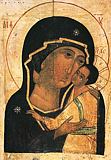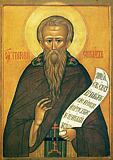

| Previous day | Next day |
| Old Style
August 8
|
Sunday |
New Style
August 21
|
|
10th Sunday after Pentecost.
Tone 1.
Успенский пост. |
Wine and oil allowed.
|
![]() St. Emilian the Confessor, bishop of Cyzicus (815-820).
St. Emilian the Confessor, bishop of Cyzicus (815-820). ![]() First (1566) and second translations of the relics of Sts. Zosimas and Sabbatius, of Solovki (1992).
First (1566) and second translations of the relics of Sts. Zosimas and Sabbatius, of Solovki (1992).
St. Myron, archbishop of Crete (ca. 350). St. Gregory, iconographer, of the Kiev Caves (12th c.). St. Gregory of Sinai (Mt. Athos) (14th c.). Martyrs Eleutherius and Leonides, of Constantinople, and many infants with them (4th c.). St. Philaret of Ichalka, Ivanovo (1913). Translation of the relics of St. Herman of Solovki (1992). Uncovering of the relics of St. Barlaam of Chikoisk Monastery (Siberia) (2002). Synaxis of the Saints of Valaam Monastery.
New Hieromartyr Joseph (Baranov), hieromonk of the Tolga Monastery (Yaroslavl) (1918). New Hieromartyr Nicholas Prozorov, priest, of Pokrovskoye (1937). New Hieromartyr Nicodemus (Krotkov), archbishop of Kostroma (1938).
“Tolga” Icon of the Most Holy Theotokos (1314) (1314).
Martyr Gormizdas of Persia (418). St. Zosimas the Sinaite, of Tuman Monastery, Serbia (14th c.). St. Gregory, wonderworker, of the Kiev Caves (14th c.). New Martyr Triandaphyllus of Zagora, at Constantinople (1680). New Martyr Anastasius (Spaso) of Strumica, at Thessalonica (1794). Monk-martyr Euthymius, abbot, of the Monastery of St. John the Baptist, at Gareji, Georgia (1804). St. Jacob, monk, of New Tuman Monastery (Serbia) (1946).
Thoughts for Each Day of the Year
According to the Daily Church Readings from the Word of God
By St. Theophan the Recluse

Tenth Sunday after Pentecost. [I Cor. 4:9-16; Matt. 17:14-23]
This kind goeth not out but by prayer and fasting. If this kind goes out by the prayer and fasting of another person, then it is even less able to enter one who fasts and prays. What protection! Although there are a slew of demons and all the air is packed with them, they cannot do anything to one who is protected by prayer and fasting. Fasting is universal temperance, prayer is universal communication with God; the former defends from the outside, whereas the latter from within directs a fiery weapon against the enemies. The demons can sense a faster and man of prayer from a distance, and they run far away from him so as avoid a painful blow. Is it feasible to think that where there is no fasting and prayer, there already is a demon? Yes, it is. The demons lodging in a person, do not always reveal their presence, but lurk there, stealthily teaching their host every evil and turning him away from every good thing; so this person is certain that he is doing everything on his own, but meanwhile he is only fulfilling the will of his enemy. Just commence prayer and fasting and the enemy will immediately depart, then wait on the side for an opportunity to somehow return again. And he truly will return, as soon as prayer and fasting are abandoned.



